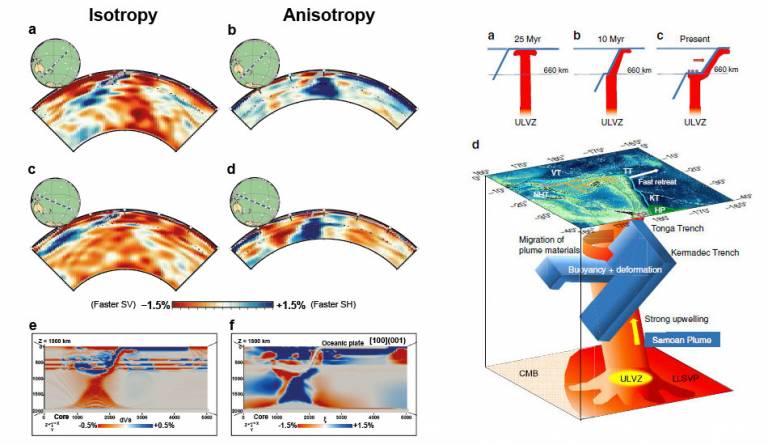How mantle plumes interact with subducting slabs from the mid-mantle to the Earth’s surface.
24 February 2016
A new study published in Nature Communications brings new insights into the patterns of flow in the Earth’s deep interior. Ana Ferreira and colleagues Sung-Joon Chang and Manuele Faccenda build the clearest picture so far on how mantle plumes can interact with subducting slabs from the mid-mantle to the Earth’s surface. This study brings new, compelling insights into the patterns of flow in the Earth’s deep interior, down to ~1,400 km beneath our feet. It provides the clearest picture so far on how mantle plumes - upwellings of hot rock within the Earth’s mantle - interact with downgoing (subducting) plates. While traditionally mantle plumes have been thought to play a passive role on the Earth’s dynamical behaviour, this study shows that, when interacting with subducting plates, they can have a very dynamic role, contributing to intense mantle deformation, to the ponding of slabs in the mid-mantle and possibly to deep earthquakes. The new insights obtained in this study have been possible through a unique, concerted combination of state-of-the-art seismic images with advanced geodynamical simulations.

Mapping flow in the Earth’s mantle is key to advance our fundamental understanding of deep Earth processes, which control plate tectonics, volcanism, earthquakes and mountain building. By building the clearest picture so far of how mantle plumes can interact with subducting slabs from the mid-mantle to the Earth’s surface, this study self-consistently explains many unique tectonic and geological features in the Tonga-Kermadec subduction region and opens the way to understand mantle flow in other regional settings.
This study suggests that significant interactions between subducting plates and mantle upwellings may be more common on Earth and more important than previously thought. Up to now, such interactions may have remained largely undetected due to limited seismic resolution and to the lack of fully concerted seismic and geodynamical interpretations. The new models open the way to hunt for possible hidden plumes beneath other slabs stagnating in the mid-mantle, to predict their geochemical and subduction kinematics signature in the geological record and to unravel their role on slab deformation, with potential strong implications in terms of the nature of material exchange between the Earth’s upper and lower mantle.
Full article: Upper- and mid-mantle interaction between the Samoan plume and the Tonga–Kermadec slabs. Sung-Joon Chang, Ana M.G. Ferreira & Manuele Faccenda. Nature Nature Communications 7, Article number: 10799 doi:10.1038/ncomms10799.
 Close
Close

